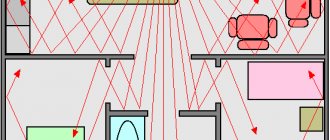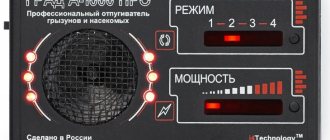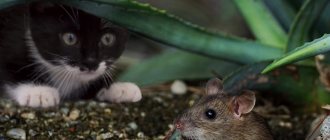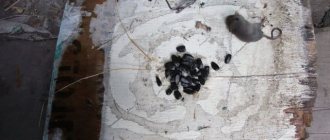Cellar mice
Cellar mice and cellar rats cause quite a lot of trouble for premises owners. When faced with this phenomenon, you only think about one thing: how to get rid of rats and mice in the cellar.
We have already discussed earlier:
- Basement mosquitoes and flies: how to get rid of them
- How to get rid of frogs in the cellar quickly and correctly
Well, a new attack, new solutions!!!
How to deal with rodents in the cellar: Prevention
If the problem has not yet affected you, it is better to take measures to prevent the appearance of rodents in the cellar or basement. It is necessary to block all their entrances and create unfavorable living conditions. To do this you should:
- cover the door to the cellar with metal sheets;
- glaze the windows;
- seal the pipe outlets;
- Cover the ventilation holes with fine mesh.
There are also repellent drugs. They are used for preventive purposes even at the stage of building a cellar or arranging a basement. For example, in the process of finishing work, you can add “Zimat” to paint or plaster. Then, in the next 3-5 years, rodents will not damage things and cables indoors.
Traditional recipes for fighting rats
You can remove rats from the basement using folk remedies:
- you won’t have to catch gray thieves if you spread tansy, black root, wild rosemary or peppermint on the floor - the aroma of these plants is not to the liking of rodents;
- Pests are also afraid of the smell of mothballs, burnt rubber, burnt wool and vinegar; cinnamon, cilantro and coriander have similar properties;
- To prevent rats from breeding in the basement, it is enough to scatter wood ash on the floor - when it gets on the animal’s paws, the substance irritates the skin. And given the fact that rodents regularly lick their limbs, the combustion product enters the gastrointestinal tract through the oral cavity. This simple remedy can help get rid of rats.
How to remove mice from the cellar: Chemical methods
There are many folk methods that will help in the fight against rodents in the cellar. For example, in villages they may advise you how to get rid of rats in the cellar using ash. Rodents are afraid of it, since the substances contained in the ash corrode the mucous membranes and paws of rats and mice. They will leave the cellar or basement on their own if the floor is covered with a layer of ash. In addition, you can find out whether mice from the basement are entering the house by following tracks in your living and utility rooms.
More radical ways to get rid of rats are the use of special drugs, such as “Ratworm”, “STORM”, “Zookoumarin”. They are added to food and placed near rodent burrows.
On the forum Lotus writes:
“The oldest and most generally accepted method of fighting rodents is grain bait based on ZOOCOUMARIN. Usually, their preparation was carried out by the SES. Now ready-made baits have appeared: CLERAT - pink granules or STORM - small blue briquettes. These two products are the most effective I have used to control mice. Moreover, the effect of the drug on rodents begins gradually, they die 4-7 days after eating, which makes it impossible for particularly cunning individuals to suspect something is wrong.”
For example, 10 g of Zookoumarin powder is mixed with 1 cup of any non-liquid porridge and 1 tablespoon of vegetable oil is added. The resulting mixture is formed into balls and placed where rats and mice can hide.
How to store potatoes from rats. Stages of potato harvesting
Harvesting tubers consists of several stages:
- Digging potatoes;
- Drying tubers;
- Transportation (or transfer to the storage location);
- Bulkhead, sorting;
- Bookmark for storage.
The last stage can vary greatly. This depends on the gardener’s capabilities (availability of storage) and his preferences.
Some people have a cellar, others only have a balcony for storage.
You can store tubers in pits, and if there is a large quantity and space available, you can build trenches.
Digging up potatoes
It’s easier, of course, to dig potatoes mechanized: with a walk-behind tractor. But not everyone has such a mechanism.
And the areas under potatoes are generally small; you can handle them with a shovel or a pitchfork.
Therefore, we harvest potatoes using these two ancient, but relevant, methods.
What exactly is up to the grower to decide.
They try to grow potatoes on light soil; if this is the case, a pitchfork will do the job. Dense soil is too much for the forks; they may break or fail to turn out the bush properly.
In dense areas you will have to dig with a shovel.
Task: select all the potatoes, if possible, and preferably whole ones. It’s not 100% possible, but you have to strive.
Damage is inevitable: a shovel sometimes cuts a tuber, a fork sometimes punctures it.
That’s why it’s so important not to overexpose the harvest: while the tops are visible, it’s easier to navigate.
Procedure:
- The bush is dug up with a shovel or pryed up with a pitchfork, and then the tubers are picked by hand. You can help yourself with a small garden trowel or a wire-toothed digger. “Comb” the holes with these teeth.
- Accidentally damaged potatoes are immediately sorted separately: the first to be used for food is unsuitable for storage.
- If it is dry, the tubers are laid out directly in the field to dry. But if there are pests, especially potato moths, the produce must be removed immediately. And away from the growing area.
- When the potatoes are healthy and free from pests, they can be stored separately as seeds. And don’t remove it as soon as it dries, remove the food from the field first.
- Green the seed a little: this way it will become more stable and will not get sick in storage. Or the waste will be minimal. Pests also do not like solanine, with the exception of the Colorado potato beetle. But the beetle is not present during storage; it prefers soil for wintering.
When carrying out greening, remember moderation. By exposing the tubers to the light and getting intensely green skin, you risk overdoing it.
The germination capacity of such tubers will decrease, and some may become non-germinating at all.
Only a slightly greenish color is acceptable.
How to catch a rat in the cellar: biological method
Our ancestors knew how to deal with rats in the cellar. They got rat-catching cats. In addition, fox terriers, hedgehogs and dogs of some other breeds are excellent rodent hunters.
At the same time, it is recommended to keep pets on a strict diet, since a well-fed animal is unlikely to make any effort to catch a mouse or rat.
Damage from basement rodents
Wherever rodents appear, they cause harm everywhere. In apartments they chew clothes, personal belongings and books, spoil wires and food supplies, and in gardens they eat the bark of fruit trees and young shoots. When faced with small pets, rats behave especially cruelly and aggressively: they easily kill small piglets, chickens and rabbits. Sometimes small dogs and cats become their victims.
Rats and mice love to chew on insulation and use it for their nests.
Why is it necessary to get rid of rats and mice immediately? Experts recommend not to delay solving this problem, since rodents are carriers of a number of dangerous diseases to which humans are susceptible. Tuberculosis, diphtheria, hemorrhagic fever and a number of skin diseases are not a complete list of diseases that these pests cause.
It is important to understand that it is not necessary to receive a bite in order to become infected. In some cases, it is enough that mice or rats from basements get to food.
How to remove mice from the cellar: mechanical methods
An effective way to combat small rodents in a basement or cellar are mousetraps. Small traps are more suitable for rats. Before using traps, you should wear rubber gloves and wash the devices to remove human odor.
Then they are lubricated with something sweet and food is placed inside, preferably fatty, such as lard or bread and butter.
Mousetraps and other spring traps are replaced every 5-10 days and checked daily. If they do not work within the first week, then consider the method ineffective and do not waste time.
You can try ultrasonic rodent repellers.
On one of the forums, user Klod writes:
“A friend has a chicken coop, and there is an ultrasonic rodent repeller in it and it works. There are no mice or rats. The chickens don't care. The device, however, was made in Brezhnev’s times (and has been working since then).”
It is better to take devices with the ability to change the frequency of the signal, since over time the rodents get used to it and cease to be afraid of the “squeaker”. The advantages of such products include safety for children and the humane nature of the method, thanks to which you do not have to deal with the corpses of rodents.
Ultrasonic repellers
Rat repellers
Ultrasonic repellers are also capable of removing rats from the cellar. They produce a sound that is unpleasant for mice, which forces the animals to leave their habitat. The use of such devices does not require regular inspection and disposal of dead individuals. However, this achievement of modern science and technology has some disadvantages:
- An effective result when using devices of this type can be achieved after three weeks of operation of the device - if the device is turned off, then there is a high probability that the rats will return again;
- the effect of getting used to the same frequency of the output signal is possible, so it is better to purchase devices that have the option of adjusting the frequency;
- In rare cases, ultrasonic frequencies can cause headaches in hypersensitive people.
On a note!
You cannot use an ultrasonic repeller in a home where there are hamsters, guinea pigs or decorative rats!
Shrew in the cellar: how to get rid of it
The shrew is another rodent that can destroy crops. Cats are effective destroyers of this animal. In addition, they can be removed by pouring 150-200 ml of a 2-3 percent ammonium nitrate solution into the burrows.
In any case, a clear design during the construction of the cellar and careful care for it will be an excellent prevention of the appearance of rodents. Entrust the construction of your cellar to professionals!
Cellars Volzhanin
Monolithic reinforced concrete cellars in Volzhanin are not susceptible to rodent infestations because they:
- Made from hydroconcrete grade M 450
- Have steel reinforcement of the body
- Are monolithic
- They have only 2 possibilities of access for rodents - through ventilation holes, which, in turn, are closed with mesh
Our cellars are ready for use and are not afraid of ground movement, snow melting and rodents.
Our managers will select the most suitable cellar configuration for you and calculate the turnkey installation.
Is it possible to eat potatoes chewed by mice?
After you destroy the pests, do not forget to carefully sort through the potatoes, discarding damaged tubers. They cannot be eaten.
Important! This work is carried out with rubber gloves to eliminate the risk of getting a dangerous infection.
SES specialists explain that potatoes that have been lightly nibbled by rats must be thoroughly washed and boiled. Only after heat treatment can it be eaten. If the tubers are thoroughly spoiled, it is better not to risk your health and throw them away.
Important information
It should be noted that today in the markets you can find special repellent devices that are designed specifically for catching rodents. These are ultrasonic repellers that can prevent rodents from appearing in the area that interests you.
This means that you can always purchase such devices, because they are also effective and proven, so in any case, decide what to do. Now you know about all the ways to fight both mice and rats, which means that you need to choose for yourself the most effective options and make sure that now your life will be calm, safe, and there will be no place in it for any then rats and mice.
You now know how to get rid of mice and rats in the cellar. Do not forget about your safety when working with various drugs. There are instructions, but the price is a quiet life without rodents.
Victor Martovich
He worked as a foreman, head of the construction and installation site. Organization of work and supervision of the quality of construction and installation works of construction sites on the territory of the Balakovo NPP, maintaining and submitting as-built documentation (magazines, acts, documents), purchasing materials, equipment (performing the duties of a supply engineer, quality engineer). Management of construction teams (registration, training in labor protection and industrial safety). Victor completed training courses under the program “Major repairs of buildings and structures. Organization of work and construction control.”, 2015 Balakovo Institute of Professional Retraining and Advanced Training, Occupational Safety and Health Specialist, 2012 Pugachevsky Irrigation College, construction technician, 2000 prof. school, accountant, 1996
Source
Strong odors and their effect on mice
In addition to sounds, pungent odors can drive rodents out of their usual habitat, so you can put them in a mouse cellar:
- peppermint oil;
- clove essential oil;
- kerosene;
- naphthalene;
- smoke bomb;
- nutmeg;
- singed wool;
- black root, which is popularly called rat racer due to its specific properties;
- camphor.
The use of most products that affect the scent sensors of mice is limited by the confined space of the cellar and the presence of products in it. If potatoes stored in the cellar are saturated with the smell of smoke, you can suffer greater losses than from damage by rodents.
Also, if it is impossible to properly ventilate the cellar, there is a danger of harm to human health due to inhalation of dangerous gases.
What are the dangers of such a neighborhood?
Rats in the entrance area pose a serious threat to both the health and property of all residents. Rodents can cause a lot of trouble, for example, chewing electrical and telephone wires, network cables. As a result, residents may be left without the Internet or without electricity. A hungry or cornered rat forgets about its fear of people and can attack and bite.
At the entrance
Rats also carry pathogens of many dangerous diseases, such as:
- plague;
- typhus;
- rabies;
- tularemia;
- toxoplasmosis.
We must also take into account the fact that basement rats will not sit in the basement for long, because so many delicious smells come from the apartments. Rodents enter apartments through ventilation, from sewer risers, through cracks in the walls or floor.
Once in an apartment, rats will eat food, leave their excrement, and damage furniture and things. And most importantly, they will run everywhere, spreading dirt and infection.
Brief characteristics of the gray rat
Not everyone knows what animal is called pasyuk. In fact, it is a gray rat. It is the largest rodent living in Russia.
Such rats live in the basement, on the lower floors of residential or warehouse buildings. Usually there is free access to food supplies and household waste, which serves as their food supply.
Main characteristics of rats inhabiting the basement:
- Pasyuk has an elongated body, its length is 20-27 cm. They weigh 150-400 g. The length of the tail is 19-20 cm.
- The rodent's muzzle is wide. There is a light mustache on it. Ears with a pinkish tint, pointed. The fur color is close to agouti (grayish-brownish). The abdomen is whitish. Paws are pink with claws.
- The border between the color of the belly and the barrels is clearly visualized. The young are completely gray, and as they grow older they develop a reddish tint.
- Rats living in the basement are highly fertile. Closer to three months, they experience puberty. In 12 months, one female is capable of producing 7-8 litters of 7-10 individuals.
Pasyuki lead a twilight lifestyle. They become more active between 7 pm and 8 am. The most fruitful time for them is 20:00-22:00.
During the day they leave their shelters only when absolutely necessary. They prefer to live in groups or colonies. They aggressively protect their territory from strangers.
Useful tips and tricks
Before moving on to the question of how to get a mouse out of the cellar, it is worth understanding what you have to fight for. What a basement rat is and understand what it reacts to and what it doesn’t like.
Then the proposed methods will be effective. You will do everything with your own hands, so all these questions are worth knowing.
Attention: Remember that rodents are distinguished by the fact that their incisors are constantly growing, they need to be ground down, which means they begin to gnaw everything that comes their way, this includes wood, concrete, etc.
- This is not to mention food products, therefore, as soon as you notice such rodents at your dacha, you need to immediately take measures that will solve such a problem.
- In general, you yourself must understand that there are many ways to fight rodents, which means you need to choose the most optimal methods that will allow you to really win it. Sounds and smells in the fight against rodents You can always start fighting rodents using easy methods, for example, repelling them.
Attention: Remember that rats and mice are afraid of loud sounds, unpleasant tastes and smells, which means you need to take this into account.
- For example, there are known cases where people installed old stereos in the cellar and turned on the music at full volume, ten minutes a day was enough to not notice any more rodents in this room.
- There is also a known case where a woman had a washing machine installed in her barn, after she put a metal basin filled with spoons and forks on it, turned on the spin cycle, there were no rodents, so you should remember this, perhaps you can do the same.
- After all, the most important thing to achieve success is that there are no rodents in the barn, and the crop remains safe and sound, so do not forget that really loud sounds are an excellent remedy for mice in the country, and you must take this into account.
Peppermint oil
As you know, it was this very remedy that helped fight mice during the Great Patriotic War, but it was not the oil that was used, but the plant itself. You should take a rag, pour peppermint oil on it, and push the rag deeper into the hole.
Attention: If the smell is unpleasant for you, then know that the entrance to the burrow can always be walled up with foam or cement mortar; in any case, the rodents will leave, because this method is proven.
How to catch rodents
Of course, every owner knows that if you get cats, ferrets and other animals, you can also effectively fight animals. But few people know that you can catch a mouse without causing it the slightest harm. Of course, you think that it is impossible to do this, but in fact, everything is far from the case.
- You will be able to carry out your plans with great ease, without much hassle and, most importantly, without material costs, which of course is nice.
- This method is famous for the fact that it has been tested, so it has proven itself well, which means you can safely use it. It is best to take a glass bottle and pour a little sunflower oil inside.
- It is best to take exactly the fragrant oil from the oil mill, because the mouse will smell it a mile away; to bait it, you can throw a piece of lard or cheese into the bottle, as a result of this, you can start waiting. Once the mouse gets into the bottle, it will not be able to get out, which means you can catch it without any problems, as you actually wanted.










